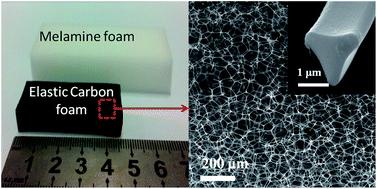Elastic carbon foam via direct carbonization of polymer foam for flexible electrodes and organic chemical absorption†
Abstract
Commonly, commercially available carbon foam derived from

* Corresponding authors
a
Department of Chemistry and Chemical Engineering, Jiangxi Normal University, Nanchang, China
E-mail:
slchen2006@yahoo.com.cn, haoqing@jxnu.edu.cn
b Institute of Urban Environment, Chinese Academy of Sciences, Xiamen, China
Commonly, commercially available carbon foam derived from

 Please wait while we load your content...
Something went wrong. Try again?
Please wait while we load your content...
Something went wrong. Try again?
S. Chen, G. He, H. Hu, S. Jin, Y. Zhou, Y. He, S. He, F. Zhao and H. Hou, Energy Environ. Sci., 2013, 6, 2435 DOI: 10.1039/C3EE41436A
To request permission to reproduce material from this article, please go to the Copyright Clearance Center request page.
If you are an author contributing to an RSC publication, you do not need to request permission provided correct acknowledgement is given.
If you are the author of this article, you do not need to request permission to reproduce figures and diagrams provided correct acknowledgement is given. If you want to reproduce the whole article in a third-party publication (excluding your thesis/dissertation for which permission is not required) please go to the Copyright Clearance Center request page.
Read more about how to correctly acknowledge RSC content.
 Fetching data from CrossRef.
Fetching data from CrossRef.
This may take some time to load.
Loading related content
